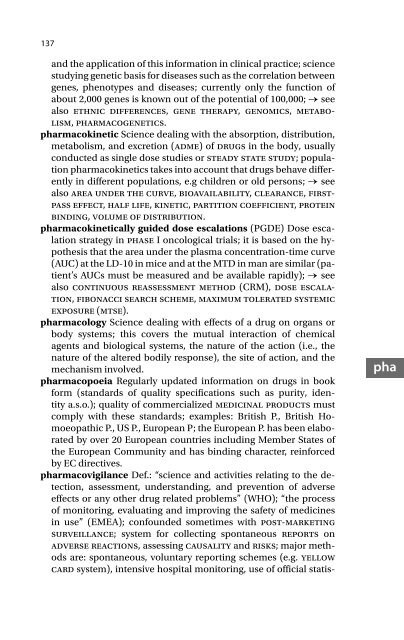220-Dictionary of Pharmaceutical Medicine, 2nd Edition-Gerhard Nahler Annette Mollet-3211898352-S
220-Dictionary of Pharmaceutical Medicine, 2nd Edition-Gerhard Nahler Annette Mollet-3211898352-S
220-Dictionary of Pharmaceutical Medicine, 2nd Edition-Gerhard Nahler Annette Mollet-3211898352-S
You also want an ePaper? Increase the reach of your titles
YUMPU automatically turns print PDFs into web optimized ePapers that Google loves.
137and the application <strong>of</strong> this information in clinical practice; sciencestudying genetic basis for diseases such as the correlation betweengenes, phenotypes and diseases; currently only the function <strong>of</strong>about 2,000 genes is known out <strong>of</strong> the potential <strong>of</strong> 100,000; → seealso ethnic differences, gene therapy, genomics, metabolism,pharmacogenetics.pharmacokinetic Science dealing with the absorption, distribution,metabolism, and excretion (adme) <strong>of</strong> drugs in the body, usuallyconducted as single dose studies or steady state study; populationpharmacokinetics takes into account that drugs behave differentlyin different populations, e.g children or old persons; → seealso area under the curve, bioavailability, clearance, firstpasseffect, half life, kinetic, partition coefficient, proteinbinding, volume <strong>of</strong> distribution.pharmacokinetically guided dose escalations (PGDE) Dose escalationstrategy in phase I oncological trials; it is based on the hypothesisthat the area under the plasma concentration-time curve(AUC) at the LD-10 in mice and at the MTD in man are similar (patient’sAUCs must be measured and be available rapidly); → seealso continuous reassessment method (CRM), dose escalation,fibonacci search scheme, maximum tolerated systemicexposure (mtse).pharmacology Science dealing with effects <strong>of</strong> a drug on organs orbody systems; this covers the mutual interaction <strong>of</strong> chemicalagents and biological systems, the nature <strong>of</strong> the action (i.e., thenature <strong>of</strong> the altered bodily response), the site <strong>of</strong> action, and themechanism involved.pharmacopoeia Regularly updated information on drugs in bookform (standards <strong>of</strong> quality specifications such as purity, identitya.s.o.); quality <strong>of</strong> commercialized medicinal products mustcomply with these standards; examples: British P., British HomoeopathicP., US P., European P; the European P. has been elaboratedby over 20 European countries including Member States <strong>of</strong>the European Community and has binding character, reinforcedby EC directives.pharmacovigilance Def.: “science and activities relating to the detection,assessment, understanding, and prevention <strong>of</strong> adverseeffects or any other drug related problems” (WHO); “the process<strong>of</strong> monitoring, evaluating and improving the safety <strong>of</strong> medicinesin use” (EMEA); confounded sometimes with post-marketingsurveillance; system for collecting spontaneous reports onadverse reactions, assessing causality and risks; major methodsare: spontaneous, voluntary reporting schemes (e.g. yellowcard system), intensive hospital monitoring, use <strong>of</strong> <strong>of</strong>ficial statis-pha


